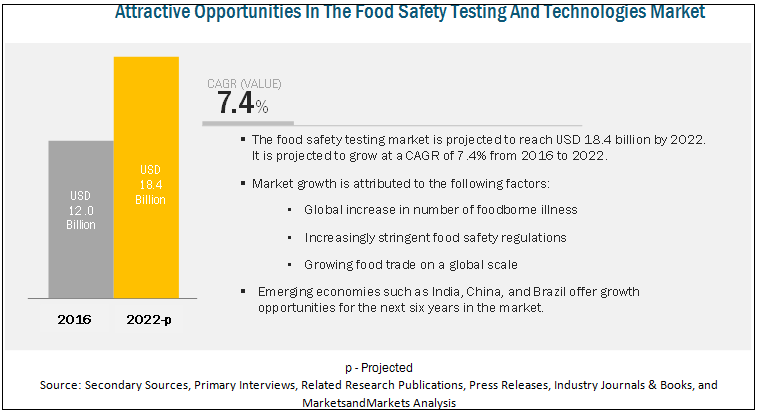‘Farm to Fork’ Food Safety Trend on a Rise Due to the Growing Consumer Awareness for Health and Wellness
The tremendously growing global food trade is evolving into complexity. Food safety has become a growing concern for consumers who are aware of the various technologies, and they demand more information regarding the products they are consuming. Food safety is an assurance that food is not contaminated and is good for consumption by the consumers. The key trends in the food safety testing industry are GMO testing, food authenticity testing, food pathogen testing, meat speciation testing, pesticide residue market, mycotoxin testing, and allergen testing. Along with this, regulatory mandates for each level in the value chain are also boosting the market growth.
Download PDF brochure: https://www.marketsandmarkets.com/pdfdownloadNew.asp?id=19285603
The global market for food safety testing and technologies is projected to reach USD 18.4 billion by 2022, recording a CAGR of 7.4%
The growing population has resulted in the rising demand for convenience and processed food. The growing food industry is eventually contributing to the growth of the food safety testing market, as farmers and manufacturers are compelled to offer high-quality agriculture produce and food products. Last few decades have observed an increase in the globalization of food trade, which has increased the risk of food contamination. The changing climatic conditions add to the problem of food safety threats. This is the reason the food safety testing market has gained importance recently. Furthermore, the rising awareness among consumers about the safety of health is fueling the global food safety testing market. With the technological advancement, the market growth is projected to be for in the next few years.
The ban on the production of GM crops has led to the high growth of the GMO testing market
The demand for GMO testing in crops has been increased due to the regulatory policies of governments of various countries, such as the Russian Federation, and a majority of the European Union nations to ban their production. The European Union, for instance, has only permitted the production of one variety of GM corn. Most of the samples tested in the European market are from imported crops or processed foods either from the US or countries in the Asia Pacific region. Due to the restricted regulations, the federal authorities opt for GMO testing to ensure the safety of products and compliance of products with regulations.
Increasing outbreak due to pathogens in food is a major market driver for pathogen testing
Incidences of foodborne illnesses have been increasing across the world. The primary incidences of foodborne illnesses have been attributed to pathogens such as salmonella, campylobacter, E. coli, and listeria. According to the FDA, in 2012, it was anticipated that nearly 48 million people in the US are affected by foodborne illnesses each year. In the US, foods with the highest chance of food poisoning are meat & poultry products. In the UK, around one million people suffer from foodborne illnesses, and nearly 20,000 people receive hospital treatment for the same. About 500 deaths have been reported due to food poisoning each year, which costs approximately Euro 1.5 billion. The prevalence of contaminants in food products responsible for foodborne illnesses has resulted in the introduction of new legislation for the implementation of pathogen testing.
Make an Inquiry: https://www.marketsandmarkets.com/Enquiry_Before_BuyingNew.asp?id=19285603
Conclusion
Rising awareness among consumers about food safety is the reason for the growth of the food safety testing market. Furthermore, the rising global food trade and foodborne illnesses have fueled the market for food safety testing. Using the right techniques and GMP for food preparation and handling processes can reduce the chance of food contamination. With technological advancement, various technologies were introduced in the food safety testing market. These include LC-MS, GC-MS, and HPCL. Among the various targets of food safety testing, GMO testing is estimated to witness the highest growth rate. The market for GMO testing is driven by the need to ensure sufficient nutrient consumption and safeguarding crops against damage. North America and Europe are the dominating regions in the food safety testing market. As water testing and analysis is an important aspect of food safety, the global bottled water testing market is projected to witness significant growth with CAGR of 5.3%. The food safety testing market is competitive, with a large number of players. The major players in the market are SGS (Switzerland), Mérieux (US), Intertek (UK), Eurofins (Luxemburg), and Bureau Veritas (France). The Asia Pacific region is an emerging market receiving investments from various multinational manufacturers, especially in countries such as China, Japan, and Australia.



